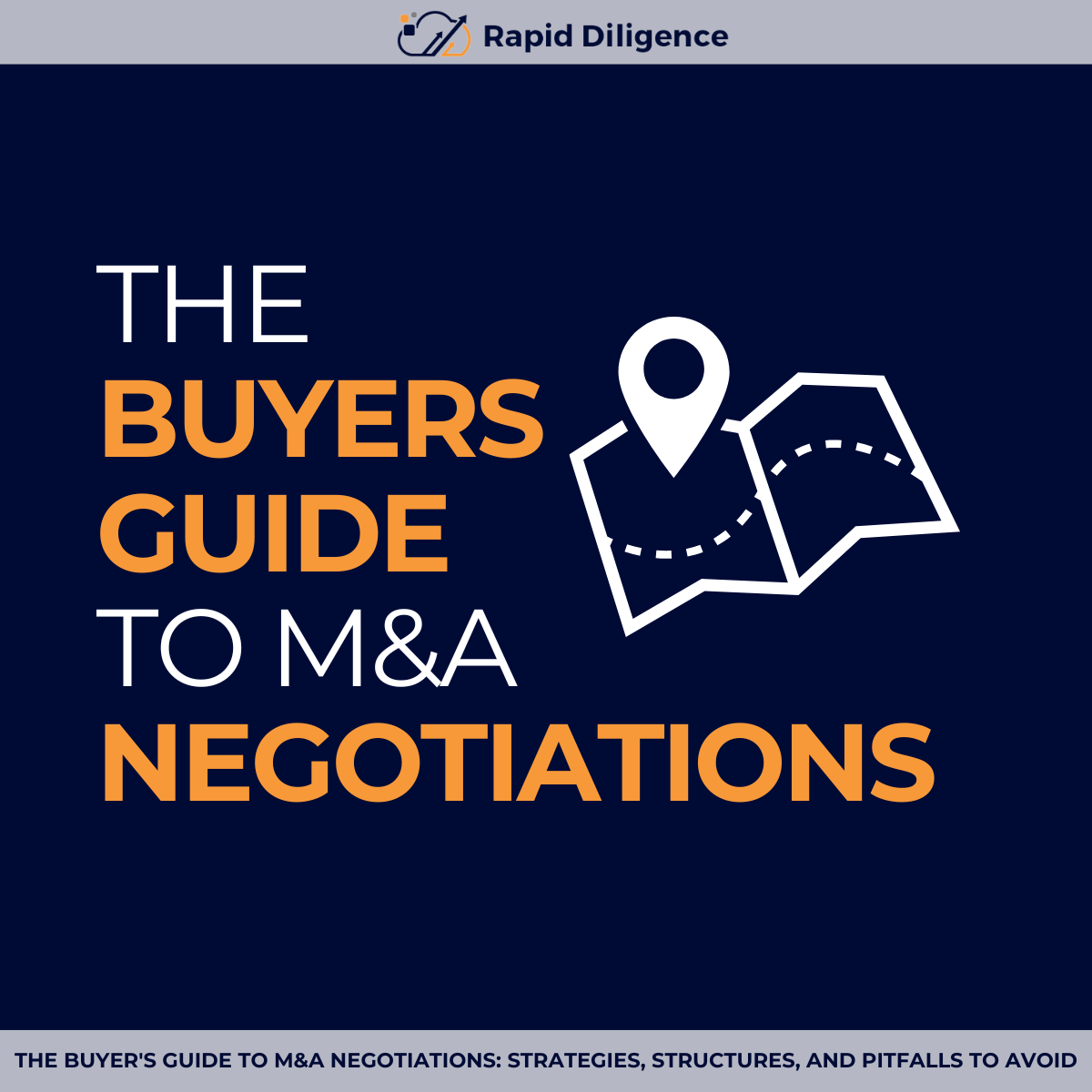For most acquisition entrepreneurs, negotiating a deal is both exciting and intimidating. It’s where strategy meets psychology — and where the success of your acquisition can be won or lost.
M&A negotiations are about far more than just “price.” Deal structure, risk allocation, timelines, and post-close dynamics all get shaped at the negotiating table. And while diligence findings will inevitably influence negotiations, preparation and approach often matter even more.
Here’s a breakdown of how smart buyers should think about M&A negotiations: from setting strategies, choosing structures, to avoiding the most common pitfalls that can derail a deal.
Understand the Goal: A “Workable” Deal
First things first: Your goal isn’t to “win” the negotiation.
Your goal is to reach a workable deal — one that protects your downside, aligns incentives post-close, and sets both parties up for a smooth transition.
Overly adversarial negotiations often backfire. Push too hard, and you risk:
- Killing seller goodwill
- Prompting retrading or counteroffers
- Introducing doubt into your financing partners
Remember, in small business M&A, relationships matter. You’ll often need the seller’s cooperation during transition — sometimes long after closing. Negotiate firmly but respectfully.
Pre-Negotiation Strategy: Preparation is Everything
Before you even start negotiating, get crystal clear on your:
- Must-haves: Non-negotiables like adjusted EBITDA targets, working capital floors, or key personnel retention.
- Nice-to-haves: Points you’re willing to compromise on, like seller financing terms or extended training periods.
- Walkaway points: The maximum risk exposure, leverage, or valuation gap you’re willing to accept.
Also, know the seller’s likely motivations:
- Are they looking for maximum cash at close?
- Do they care about legacy and finding the “right” buyer?
- Are they willing to finance part of the deal?
The more you understand their priorities, the more effectively you can structure your offer.
Key Deal Structures to Consider
Price matters, but how you structure the deal matters just as much. Different structures offer different protections and risks for buyers.
Asset Sale vs. Stock Sale
In an asset sale, the buyer purchases specific assets and liabilities, offering a cleaner separation from past obligations. In a stock sale, the buyer acquires ownership shares directly, which can seem simpler but often carries hidden liabilities. Most small business deals are structured as asset sales to minimize legacy risks.
Cash at Close, Seller Financing, and Earnouts
Cash at close is the cleanest outcome for the seller but places the most upfront risk on the buyer. Seller financing allows the buyer to spread payments over time, keeping the seller invested in post-close success. Earnouts tie future payments to specific business performance metrics, aligning incentives but also adding complexity.
Blending these payment structures can help align interests and create a more balanced, lower-risk deal.
Working Capital Pegs
Negotiations around working capital often get overlooked early but become critical at closing. Setting clear expectations for “normalized” working capital prevents disputes and ensures you’re not inheriting unexpected liquidity shortfalls. Define working capital terms early to avoid last-minute renegotiations.
The Role of Diligence in Negotiations
Your Quality of Earnings (QoE), operational diligence, and legal reviews will absolutely shape your final negotiation stance.
Common diligence-driven negotiation levers include:
- EBITDA adjustments: Correcting inflated seller figures.
- Customer concentration risks: Justifying lower multiples.
- Legal risks: Introducing escrow holdbacks or indemnifications.
- Operational risks: Negotiating extended seller support or additional training.
Good diligence findings aren’t just for walking away from bad deals — they’re powerful tools for recalibrating deal terms.
Pitfalls to Avoid During M&A Negotiations
Even experienced buyers can fall into negotiation traps. Here’s what to watch for:
Getting Emotionally Attached
Falling in love with a deal blinds you to risk. Always be willing to walk away if necessary. Discipline beats emotion every time.
Focusing Only on Price
Sellers often fixate on the headline price because it’s simple and tangible. But smart buyers know that total deal economics — including structure, timing, liabilities, and risk-sharing — are far more important.
A lower price with bad structure is worse than a slightly higher price with good protections.
Moving Too Fast
Rushed negotiations usually favor the seller. Buyers who feel pressured tend to skip thorough diligence, accept seller’s representations at face value, and miss opportunities to build better terms. Set a realistic timeline and stick to it.
Over-Negotiating
Buyers sometimes nickel-and-dime small points, losing seller trust over non-material issues. Focus on big-ticket risks and items that materially affect value or operations, not minor inconveniences.
Ignoring Post-Close Dynamics
Getting a seller to the finish line is only half the battle. The transition period — knowledge transfer, customer introductions, employee retention — can make or break success post-close. Negotiate not just for the sale, but for a strong, functional first 90 to 180 days after it.
Negotiating Tips for Acquisition Entrepreneurs
- Anchor early but reasonably. Don’t lowball without justification. Sellers can shut down if they feel insulted.
- Be data-driven. Base offers and counteroffers on real diligence findings and comps, not “gut feel.”
- Keep emotions in check. Sellers are emotional too. Treat the business — and the seller’s legacy — with respect.
- Use advisors wisely. Bring your attorney and CPA into key phases, but don’t let them dominate tone or slow momentum unnecessarily.
- Stay focused on outcomes. Every point you argue should tie back to risk mitigation or value creation.
What Winning Negotiations Look Like
Winning negotiations in M&A don’t always mean getting the “best deal.” They mean:
- You clearly understand what you’re buying (and what you’re not)
- Risks are appropriately priced or structured
- Both sides feel the deal is fair and workable
- Transition plans are set up for success
Great deals leave everyone a little uncomfortable — and a little excited. That’s how you know the risk and reward are balanced.
Final Thoughts
M&A negotiations are complex, high-stakes, and often emotionally charged. But with preparation, discipline, and the right mindset, you can negotiate deals that not only close but succeed long-term.
Use diligence findings smartly. Focus on structure as much as price. Protect your downside while building bridges, not walls, with the seller.
Because at the end of the day, negotiation isn’t about winning a battle — it’s about setting the foundation for a successful ownership journey.
Contact us today or book a free consultation and learn how we can be a trusted partner on your next deal!







